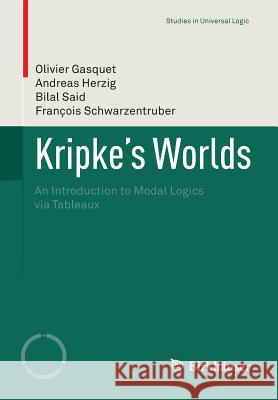Kripke's Worlds: An Introduction to Modal Logics Via Tableaux » książka
Kripke's Worlds: An Introduction to Modal Logics Via Tableaux
ISBN-13: 9783764385033 / Angielski / Miękka / 2013 / 198 str.
Possible world models were introduced by Saul Kripke in the early 1960s. Basically, a possible worlds model is nothing but a graph with labelled nodes and labelled edges. Such graphs provide semantics for various modal logics: logics of necessity and possibility (alethic logics), logics of time (temporal logics), logics of knowledge and belief (epistemic and doxastic logics), logics of programs and of action (dynamic logics), logics of obligation (deontic logics), as well as for logics for describing ontologies (description logics). They have also turned out useful for other nonclassical logics such as intuitionistic logics, conditional logics, and several paraconsistent and relevant logics. All these logics have been studied intensively in philosophical and mathematical logic and in computer science, and have been applied increasingly in various domains such as program semantics, artificial intelligence, and more recently in the semantic web.All these logics were not only studied semantically but also proof theoretically. The proof systems for modal logics come in various styles: Hilbert style, natural deduction, sequents, and resolution. However, it is fair to say that the most uniform and most successful such systems are tableaux systems. Given a logic and a formula, they allow one to check whether there is a model in that logic. This basically amounts to trying to build a model for the formula by building a tree. In this book we follow a more general approach and try to build a graph, the advantage being that a graph is closer to a Kripke model than a tree. This book provides a step-by-step introduction to possible worlds semantics (and by that to modal and other nonclassical logics) via the tableaux method. It is accompanied by a piece of software called LoTREC (www.irit.fr/Lotrec). LoTREC allow one to check whether a given formula is true at a given world of a given model and to check whether a given formula is satisfiable in a given logic. The latter can be done immediately if the tableau system for that logic has already been implemented in LoTREC. For logics for which this has not been done yet LoTREC offers the possibility to implement a tableau system in a relatively easy way: users need not be computer scientists in order to implement new modal logics, thanks to a simple, graph-based, interactive language.











